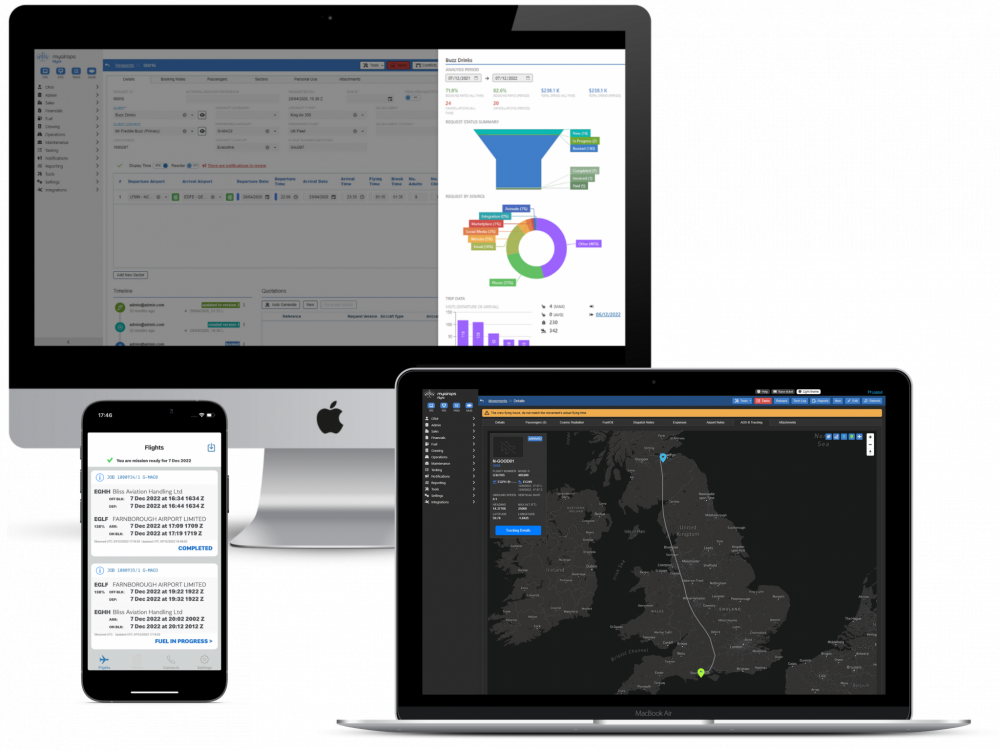Flight management software has revolutionized the aviation industry by streamlining operations, enhancing efficiency, and improving safety. As operators embrace this technology, it’s important to identify the essential features and capabilities that make flight management software a valuable asset. This blog post will explain the must-haves for operators utilizing flight management software to ensure seamless flight operations and optimal performance.
- User-Friendly Interface: One of the crucial aspects of flight management software is a user-friendly interface. The software should be intuitive and easy to navigate, allowing operators to efficiently input and retrieve data. A well-designed interface minimizes the learning curve and maximizes productivity, ensuring a smooth user experience for operators.
- Comprehensive Flight Planning and Optimization: Flight management software should consider various factors such as weather conditions, airspace restrictions, aircraft performance, and fuel consumption. By incorporating advanced algorithms, the software should generate optimal flight paths, reduce fuel burn, and enhance efficiency, ultimately saving time and reducing costs.
- Real-time Data Integration: The ability to integrate real-time data is crucial for operators using flight management software. This includes data from weather services, air traffic control, NOTAMs, and aircraft systems. Real-time data integration enables operators to make informed decisions promptly, adapt flight plans as necessary, and enhance overall situational awareness.
- Documentation and Compliance Management: Flight management software should include robust documentation and compliance management features. It should allow operators to easily manage and access critical documents such as flight plans, NOTAMs, charts, and regulations. Additionally, the software should assist in ensuring compliance with regulatory requirements, automating processes, and reducing the risk of errors.
- Communication and Collaboration Tools: Efficient communication and collaboration among stakeholders are essential for successful flight operations. Flight management software should provide tools for seamless communication between pilots, dispatchers, ground personnel, and other stakeholders. Features like messaging systems, automated alerts, and shared calendars can enhance coordination and reduce miscommunication.
- Integration with External Systems: To streamline operations, flight management software should offer integration capabilities with external systems. This includes integration with airline operational control systems (OCC), maintenance tracking systems, crew management systems, and fuel management systems. Integration enhances data flow and minimizes manual data entry, reducing errors and optimizing operational efficiency.
- Mobile Accessibility: In today’s fast-paced aviation environment, having access to flight management software on mobile devices is highly beneficial. Mobile accessibility allows operators to access critical information and perform necessary tasks on the go, ensuring flexibility and responsiveness in managing flight operations.
Flight management software has become an indispensable tool for aviation operators, revolutionizing the way flight operations are managed. By prioritizing essential features such as a user-friendly interface, comprehensive flight planning and optimization, real-time data integration, documentation and compliance management, communication and collaboration tools, integration with external systems, and mobile accessibility, operators can maximize the benefits of this technology. Investing in a robust flight management software solution that encompasses these must-haves is a strategic move towards enhancing operational efficiency, safety, and overall success in the aviation industry.
The one stop shop for all operators needs is myairops flight.

myairops flight is a complete cloud-based SaaS flight operations management platform providing the tools to reduce operational complexities, streamline flight operations, boost sales and reduce costs. Used by aircraft operators worldwide; supporting all forms of operations and brokers.
Accessible from anywhere in the world through any device that supports a web browser. myairops flight combines an intuitive user interface with a powerful automation engine. The system is provided as a platform with APIs allowing organizations and third parties to build custom tools, integrations and value-added capabilities. ODATA is provided to allow access to data and integration with business intelligence tools.
The system is provided with a real-time data feed that provides live updates for critical operational data such as airports, airport opening hours, customs information, FBOs and other service provider information. This is continually enhanced by our own trip support organization.
The myairops flight product is fully compatible with our dedicated myairops crew app.
The intuitive and configurable iOS and iPadOS based app reduces and streamlines communications between operational staff and crew and ground staff such as pilots, maintenance engineers and flight attendants.
Available from Apple’s AppStore and seamlessly connected with the myairops flight product, myairops crew allows the instant transfer of data, digital trip sheets, tailorable pre-departure and post flight checklists, capture of hours and cycle information across aircraft assemblies, currency recording, VOR checks, delay recording, fuel transactions, and many other features. In addition, the application provides notifications as changes happen without manual intervention. Ensuring staff are not overwhelmed by real-time alerts, the system intelligently batches up notifications and updates such as time changes, aircraft swaps, airport and FBO changes, passenger manifest changes, and fuel release information.





